Desiccant-Based Air Handling Unit Alternatively Equipped with Three Hygroscopic Materials and Driven by Solar Energy
Abstract
:1. Introduction
- -
- different solar thermal field configurations, three collecting surfaces (about 20, 27 and 34 m2) and different tilt angles (20–55°);
- -
- three desiccant rotor materials, that is the one which is actually installed in an available test plant (silica-gel), a composite material denominated MIL101@GO-6 (MILGO), made of graphite oxide dispersed in the MIL101 metal organic framework structure, and a naturally occurring zeolite-rich tuff, denominated Campanian Ignimbrite, which is rich in phillipsite and chabazite and is widespread in many areas of Campania region, in southern Italy.
2. Hygroscopic Materials: Modeling and Characterization
3. Methodology: Simulation Models, Plant Configuration and Analyses
- numerical simulations, carried out to dynamically assess the energy flows in the considered plants;
- energy and environmental analyses based on seasonal and annual aggregated results.
3.1. Plants Simulation Model Characteristics and Operation
3.2. Energy and Environmental Indexes
- -
- the solar fraction (SF), that is the share of thermal enegy from the solar subsystem on the total thermal energy required by the AHU in the IS;
- -
- the solar energy factor (SEF), that represents the ratio between the solar energy used in the AHU and that totally available.
- -
- the ratio between the solar energy used to regenerate the desiccnt wheel () and the total regeneration energy ():
- -
- the ratio between the solar energy used to regenerate the desiccant rotor and the total termal energy available from SC in summer (),
- -
- the primary energy saving (PES) achieved by IS with respect to CS;
- -
- the equivalent CO2 emissions avoided by IS with respect to CS.
4. Results
4.1. Energy Analysis
4.2. Environmental Analysis
5. Discussion
6. Conclusions
Author Contributions
Funding
Conflicts of Interest
Nomenclature
| CO2 | Equivalent CO2 emission (kg/year) |
| cp | Specific heat (J/kgK) |
| Ds | Surface diffusion coefficient (m2/s) |
| E | Energy (MWh/y) |
| F1, F2 | Isopotential lines |
| K | Effective mass transfer coefficient (1/s) |
| k | Thermal conductivity (W/mK) |
| M | Moisture content of adsorbent material (kgwater/kgadsorbent) |
| Mw | Molecular weight of water (kg/mol) |
| PES | Primary Energy Saving (%) |
| qs | isosteric heat of adsorption (J/mol) |
| SEF | Solar Energy Factor (-) |
| SF | Solar Fraction (-) |
| T, t | Temperature (K), (°C) |
| V | air superficial velocity (m/s) |
| z | Axial coordinate (m) |
| Greek symbols | |
| α | Specific emission factor of electricity drawn from the grid (kg CO2/kW hel) |
| β | Specific emission factor of primary energy related to natural gas combustion (kg CO2/kW hEp) |
| ΔCO2 | Equivalent CO2 avoided emission (%) |
| ε | Void fraction (-) |
| η | Efficiency (-) |
| θ | Time (s) |
| ρ | Density (kg/m3) |
| ω | Air absolute humidity (kgwater/kgdry air) or (gwater/kgdry air) |
| Superscripts | |
| CS | Conventional System |
| DC | Dry cooler |
| DWreg | Desiccant Wheel regeneration |
| IS | Innovative System |
| postheat | Post-heating phase |
| preheat | Pre-heating phase |
| TS | Thermal Storage |
| US | User |
| Subscripts | |
| amb | Ambient |
| aux | Auxiliaries |
| B | Boiler |
| CH | Chiller |
| Co | Cooling |
| Cooling | Cooling mode |
| d | Adsorbent materia |
| e | At equilibrium condition |
| EG | Electric Grid |
| el | Electric |
| F1, F2 | Isopotential lines |
| Heating | Heating mode |
| in | Initial |
| m | moist air |
| non-HVAC | not related to HVAC |
| p | Primary |
| PP | Power Plant |
| proc | Process |
| reg | Regeneration |
| SC | Solar thermal Collector |
| th | Thermal |
| tot, Total | Total |
| Acronyms | |
| AHU | Air Handling Unit |
| B | Boiler |
| CC | Cooling Coil |
| CF | Cross-Flow heat exchanger |
| CH | Chiller |
| COP | Coefficient Of Performance |
| CS | Conventional System |
| DW | Desiccant Wheel |
| EC | Evaporative Cooler |
| HC, HC2 | Heating Coils |
| HVAC | Heating, Ventilation and Air-Conditioning |
| HW-HX | Hot Water Heat exchanger |
| IS | Innovative System |
| MILGO Hygroscopic material, consisting graphite oxide dispersed in the MIL101 metal organic framework network structure | |
| SC | Solar thermal Collector |
| SEF | Solar Energy Factor |
| SF | Solar Fraction |
| TS | Thermal Storage |
References
- Zheng, X.; Ge, T.S.; Wang, R.Z. Recent progress on desiccant materials for solid desiccant cooling systems. Energy 2014, 74, 280–294. [Google Scholar] [CrossRef]
- Asim, N.; Emdadi, Z.; Mohammad, M.; Yarmo, M.A.; Sopian, K. Agricultural solid wastes for green desiccant applications: An overview of research achievements, opportunities and perspectives. J. Clean. Prod. 2015, 91, 26–35. [Google Scholar] [CrossRef]
- Jani, D.B.; Mishra, M.; Sahoo, P.K. Performance analysis of a solid desiccant assisted hybrid space cooling system using TRNSYS. J. Build. Eng. 2018, 19, 26–35. [Google Scholar] [CrossRef]
- Al-Alili, A.; Hwang, Y.; Radermacher, R. Performance of a desiccant wheel cycle utilizing new zeolite material: Experimental investigation. Energy 2015, 81, 137–145. [Google Scholar] [CrossRef]
- Kanoğlu, M.; Çarpınlıoğlu, M.Ö.; Yıldırım, M. Energy and exergy analyses of an experimental open-cycle desiccant cooling system. Appl. Therm. Eng. 2004, 24, 919–932. [Google Scholar] [CrossRef]
- Subramanyam, N.; Maiya, M.P.; Srinivasa Murthy, S. Application of desiccant wheel to control humidity in air-conditioning systems. Appl. Therm. Eng. 2004, 24, 2777–2788. [Google Scholar] [CrossRef]
- Jia, C.X.; Dai, Y.J.; Wu, J.Y.; Wang, R.Z. Experimental comparison of two honeycombed desiccant wheels fabricated with silica gel and composite desiccant material. Energy Convers. Manag. 2006, 47, 2523–2534. [Google Scholar] [CrossRef]
- White, S.D.; Goldsworthy, M.; Reece, R.; Spillmann, T.; Gorur, A.; Lee, D.Y. Characterization of desiccant wheels with alternative materials at low regeneration temperatures. Int. J. Refrig. 2011, 34, 1786–1791. [Google Scholar] [CrossRef]
- Eicker, U.; Schürger, U.; Köhler, M.; Ge, T.; Dai, Y.; Li, H.; Wang, R. Experimental investigations on desiccant wheels. Appl. Therm. Eng. 2012, 42, 71–80. [Google Scholar] [CrossRef]
- Jia, C.X.; Dai, Y.J.; Wu, J.Y.; Wang, R.Z. Analysis on a hybrid desiccant air-conditioning system. Appl. Therm. Eng. 2006, 26, 2393–2400. [Google Scholar] [CrossRef]
- Fong, K.F.; Lee, C.K. Impact of adsorbent characteristics on performance of solid desiccant wheel. Energy 2018, 144, 1003–1012. [Google Scholar] [CrossRef]
- Intini, M.; Goldsworthy, M.; White, S.; Joppolo, C.M. Experimental analysis and numerical modelling of an AQSOA zeolite desiccant wheel. Appl. Therm. Eng. 2015, 80, 20–30. [Google Scholar] [CrossRef]
- Goldsworthy, M.J. Measurements of water vapour sorption isotherms for RD silica gel, AQSOA-Z01, AQSOA-Z02, AQSOA-Z05 and CECA zeolite 3A. Microporous Mesoporous Mater. 2014, 196, 59–67. [Google Scholar] [CrossRef]
- Enteria, N.; Yoshino, H.; Mochida, A.; Satake, A.; Yoshie, R.; Takaki, R.; Yonekura, H.; Mitamura, T.; Tanaka, Y. Performance of solar-desiccant cooling system with silica–gel (SiO2) and titanium dioxide (TiO2) desiccant wheel applied in East Asian climates. Sol. Energy 2012, 86, 1261–1279. [Google Scholar] [CrossRef]
- Rajamani, M.; Maliyekkal, S.M. Chitosan reinforced boehmite nanocomposite desiccant: A promising alternative to silica gel. Carbohydr. Polym. 2018, 194, 245–251. [Google Scholar] [CrossRef] [PubMed]
- Yan, J.; Yu, Y.; Ma, C.; Xiao, J.; Xia, Q.; Li, Y. Adsorption isotherms and kinetics of water vapor on novel adsorbents MIL-101(Cr)@GO with super-high capacity. Appl. Therm. Eng. 2015, 84, 118–125. [Google Scholar] [CrossRef]
- Caputo, D.; Iucolano, F.; Pepe, F.; Colella, C. Modeling of water and ethanol adsorption data on a commercial zeolite-rich tuff and prediction of the relevant binary isotherms. Microporous Mesoporous Mater. 2007, 105, 260–267. [Google Scholar] [CrossRef]
- Bareschino, P.; Diglio, G.; Pepe, F.; Angrisani, G.; Roselli, C.; Sasso, M. Numerical study of a MIL101 metal organic framework based desiccant cooling system for air conditioning application. Appl. Therm. Eng. 2017, 124, 641–651. [Google Scholar] [CrossRef]
- Bareschino, P.; Diglio, G.; Pepe, F. Modelling of a Zeolite-Rich Tuff Desiccant Wheel. Adv. Sci. Lett. 2017, 23, 6002–6006. [Google Scholar] [CrossRef]
- Maclaine-Cross, I.L.; Banks, P.J. Coupled heat and mass transfer in regenerators– predictions using an analogy with heat transfer. Int. J. Heat Mass Transf. 1972, 15, 1225–1242. [Google Scholar] [CrossRef]
- Howe, R.R. Model and Performance Characteristics of a Conditioning System Which Utilizes a Rotary Desiccant Dehumidifier. Master’s Thesis, University of Wisconsin, Madison, WI, USA, 1983. [Google Scholar]
- Jurinak, J.J. Open Cycle Solid Desiccant Cooling: Component Models and System Simulations. Ph.D. Thesis, University of Wisconsin, Madison, WI, USA, 1982. [Google Scholar]
- Banks, P.J. Prediction of Heat and Mass Regenerator performance using nonlinear analogy method: Part 1—basis. ASME J. Heat Transf. 1985, 107, 222–229. [Google Scholar] [CrossRef]
- Angrisani, G.; Roselli, C.; Sasso, M. Experimental validation of constant efficiency models for the subsystems of an unconventional desiccant-based Air Handling Unit and investigation of its performance. Appl. Therm. Energy 2012, 33–34, 100–108. [Google Scholar] [CrossRef]
- Solar Energy Laboratory. TRNSYS 17, a TRaNsient System Simulation Program; University of Wisconsin: Madison, WI, USA, 2010. [Google Scholar]
- Thermal Energy System Specialists Components Library v. 17.01; Thermal Energy System Specialists: Madison, WI, USA, 2004.
- Angrisani, G.; Roselli, C.; Sasso, M.; Tariello, F.; Vanoli, G.P. Performance Assessment of a Solar-Assisted Desiccant-Based Air Handling Unit Considering Different Scenarios. Energies 2016, 9, 724. [Google Scholar] [CrossRef]
- Angrisani, G.; Roselli, C.; Sasso, M.; Tariello, F. Dynamic performance assessment of a micro-trigeneration system with a desiccant-based air handling unit in Southern Italy climatic conditions. Energy Convers. Manag. 2014, 80, 188–201. [Google Scholar] [CrossRef]
- Angrisani, G.; Canelli, M.; Roselli, C.; Sasso, M. Calibration and validation of a thermal energy storage model: Influence on simulation results. Appl. Therm. Eng. 2014, 67, 190–200. [Google Scholar] [CrossRef]
- Angrisani, G.; Roselli, C.; Sasso, M.; Tariello, F. Dynamic performance assessment of a solar-assisted desiccant-based air handling unit in two Italian cities. Energy Convers. Manag. 2016, 113, 331–345. [Google Scholar] [CrossRef]
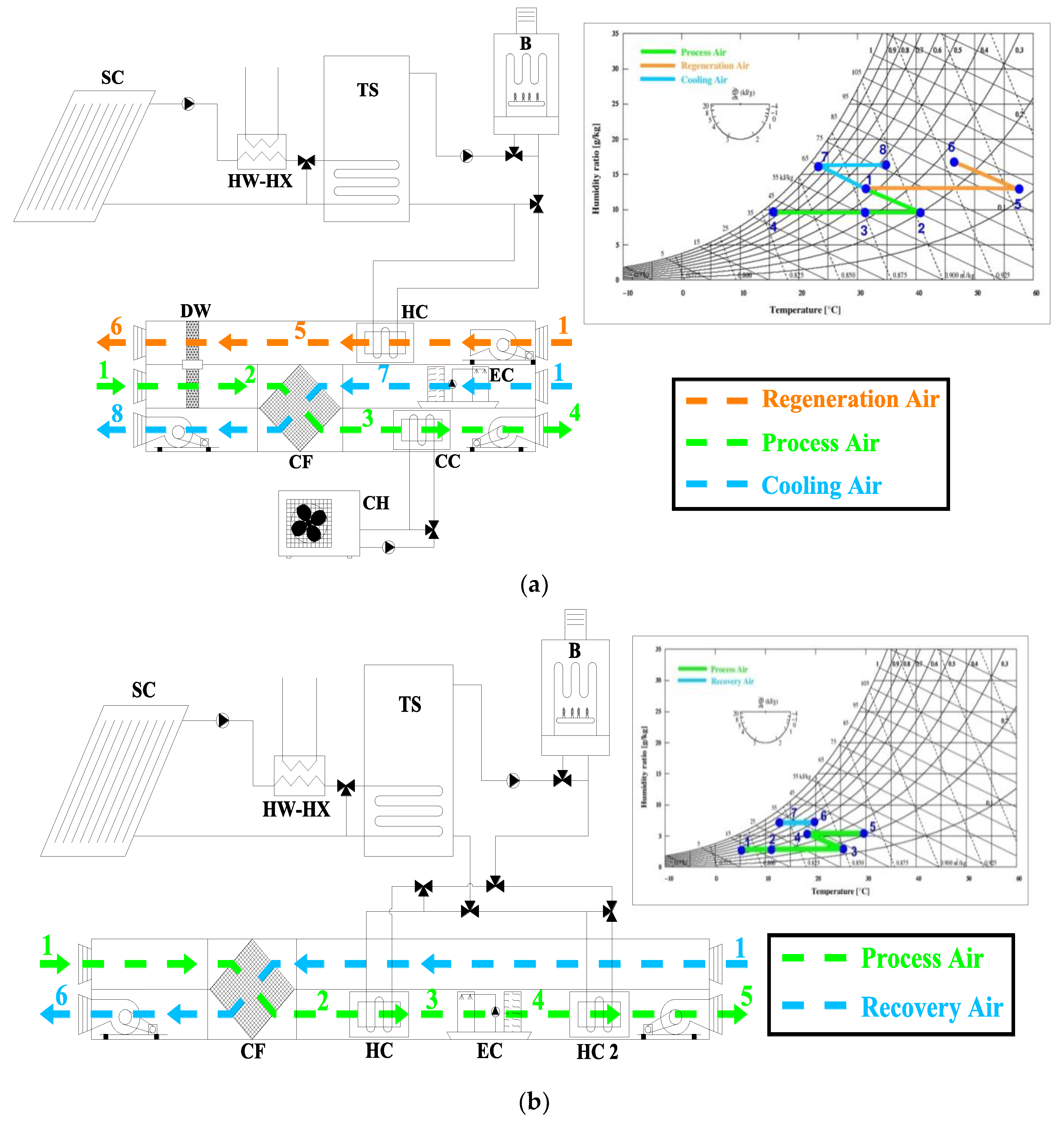
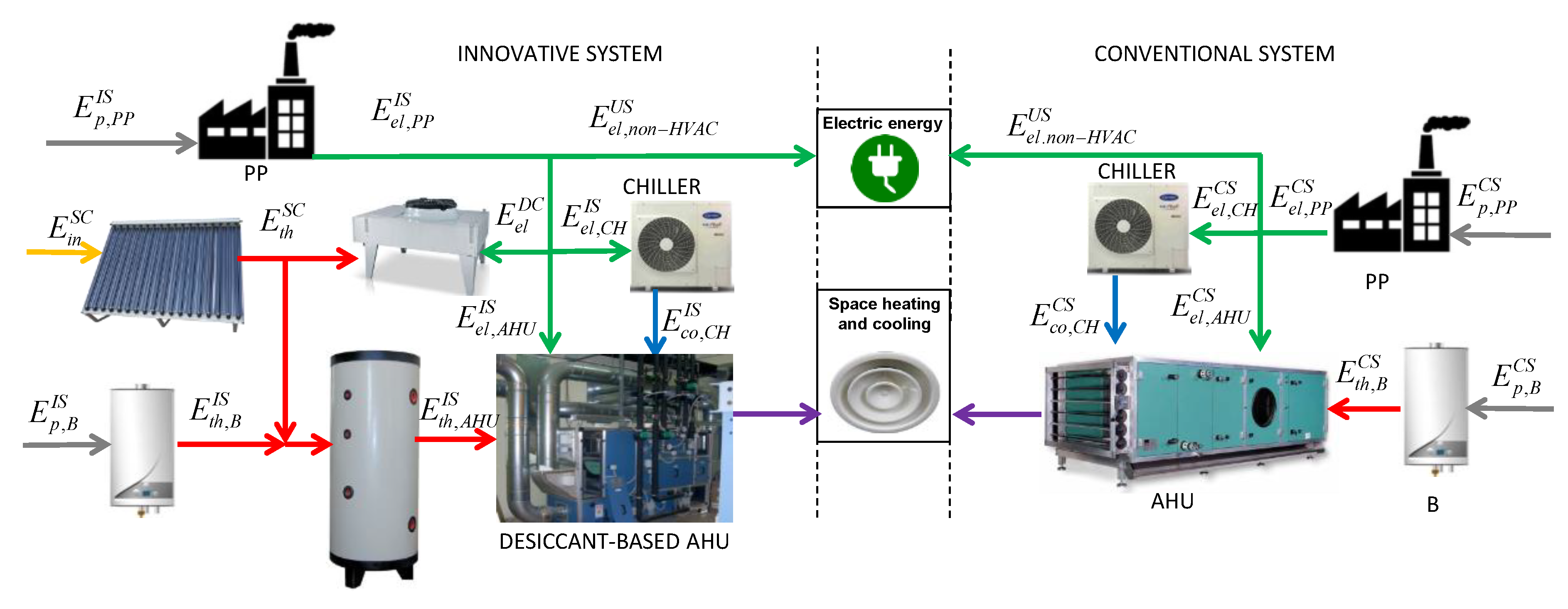
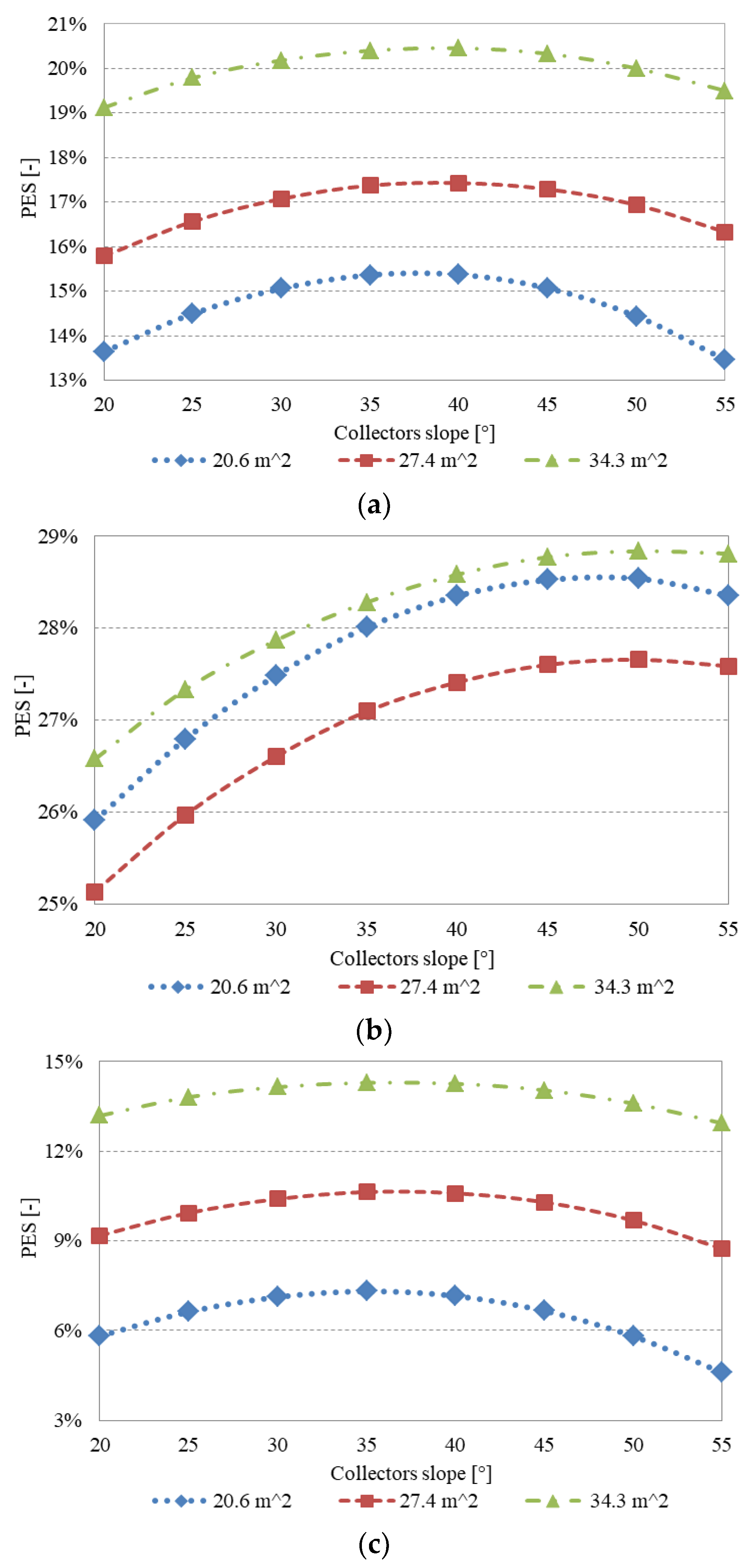


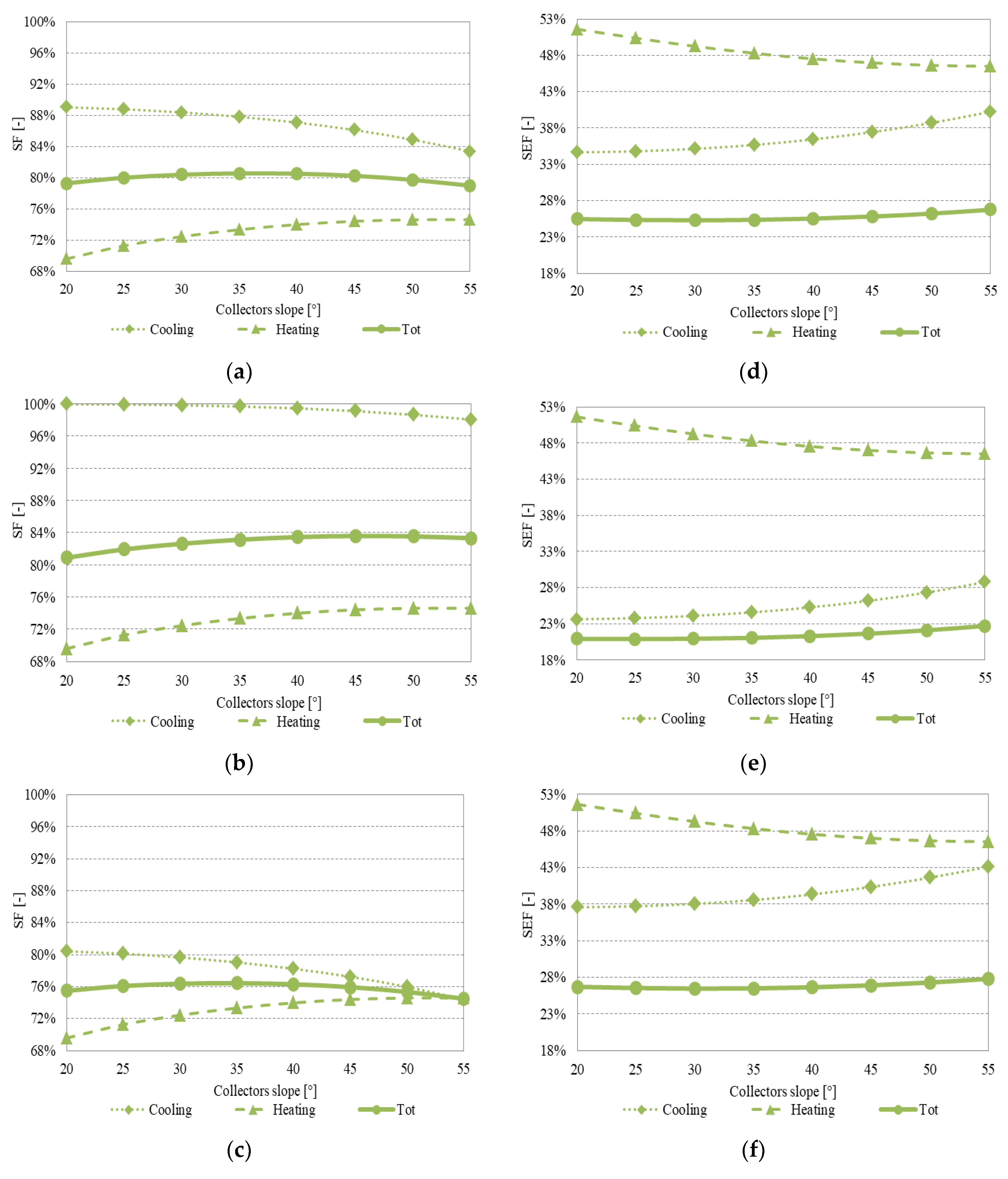
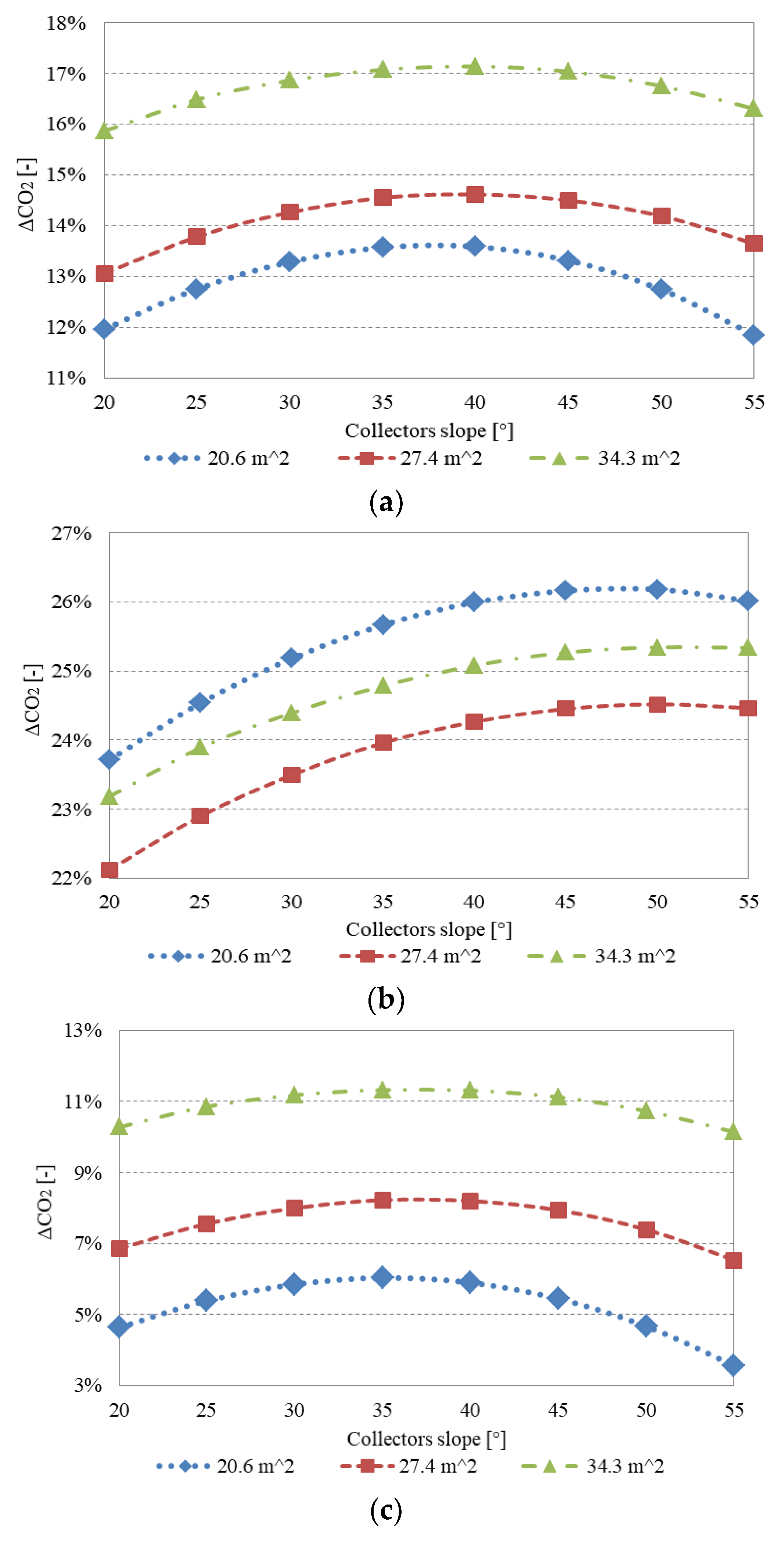

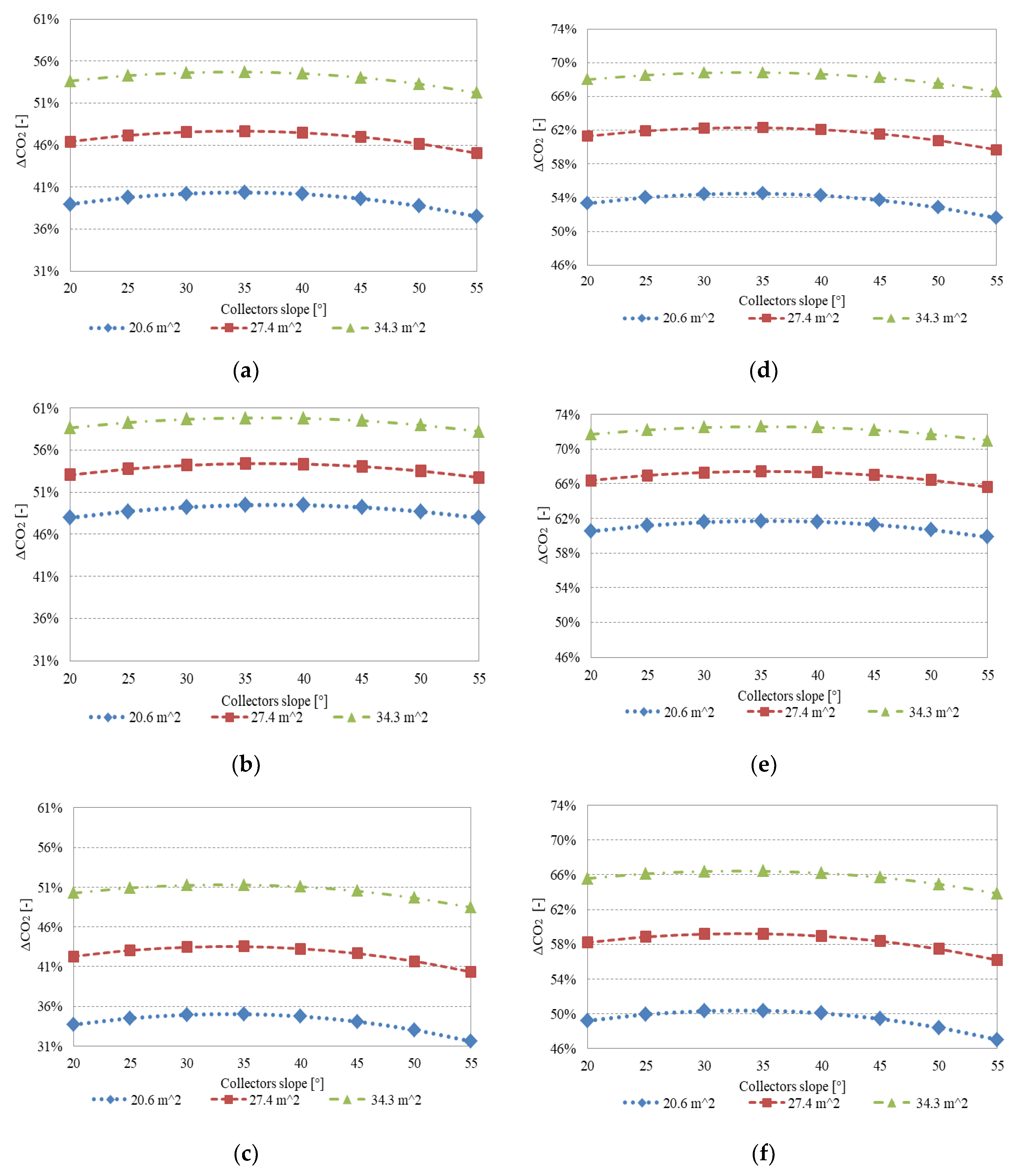
| Parameter | Opaque Components | Transparent Components | |||||
|---|---|---|---|---|---|---|---|
| Roof | External Walls (N/S) | External Walls (E/W) | On the Ground Floor | North | South | East/West | |
| U (W/m2 K) | 2.30 | 1.11 | 1.11 | 0.297 | 2.83 | 2.83 | 2.83 |
| Area (m2) | 63.5 | 36 | 15.87 | 63.5 | 8.53 | 9.40 | 0.976 |
| g (-) | - | - | - | - | 0.755 | 0.755 | 0.755 |
| Component (Reference) | Type | Library | Main Parameters | Value | Units |
|---|---|---|---|---|---|
| Cross flow heat exchanger [24] | 91 | Standard | Effectiveness | 0.446 | - |
| Humidifier [24] | 506 c | TESS | Saturation efficiency | 0.551 | - |
| Natural gas boiler [24] | 6 | Standard | Nominal thermal power | 24.1 | kW |
| Efficiency | 0.902 | - | |||
| Air-cooled chiller [24] | 655 | TESS | Rated capacity | 8.50 | kW |
| Rated COP | 2.98 | - | |||
| Heating coil [24] | 670 | TESS | Liquid specific heat | 4.190 | kJ/(kg·K) |
| Effectiveness | 0.864 | - | |||
| Cooling coil [24] | 508 | TESS | Liquid specific heat | 4.190 | kJ/(kg·K) |
| Bypass fraction | 0.177 | - | |||
| Storage tank [29] | 60 f | Standard | Volume | 971 | L |
| Height | 2.04 | m | |||
| Tank loss coefficient | 1.37 | W/(m2·K) | |||
| Liquid specific heat | 4.190 | kJ/(kg·K) | |||
| Evacuated solar collectors | 71 | Standard | Tested flow rate | 8.43 × 10−3 | kg/(s·m2) |
| Intercept efficiency | 0.676 | - | |||
| Efficiency slope | 1.15 | W/(m2·K) | |||
| Efficiency curvature | 0.004 | W/(m2·K2) | |||
| Fluid specific heat | 3.85 | kJ/(kg·K) |
© 2019 by the authors. Licensee MDPI, Basel, Switzerland. This article is an open access article distributed under the terms and conditions of the Creative Commons Attribution (CC BY) license (http://creativecommons.org/licenses/by/4.0/).
Share and Cite
Bareschino, P.; Pepe, F.; Roselli, C.; Sasso, M.; Tariello, F. Desiccant-Based Air Handling Unit Alternatively Equipped with Three Hygroscopic Materials and Driven by Solar Energy. Energies 2019, 12, 1543. https://doi.org/10.3390/en12081543
Bareschino P, Pepe F, Roselli C, Sasso M, Tariello F. Desiccant-Based Air Handling Unit Alternatively Equipped with Three Hygroscopic Materials and Driven by Solar Energy. Energies. 2019; 12(8):1543. https://doi.org/10.3390/en12081543
Chicago/Turabian StyleBareschino, Piero, Francesco Pepe, Carlo Roselli, Maurizio Sasso, and Francesco Tariello. 2019. "Desiccant-Based Air Handling Unit Alternatively Equipped with Three Hygroscopic Materials and Driven by Solar Energy" Energies 12, no. 8: 1543. https://doi.org/10.3390/en12081543
APA StyleBareschino, P., Pepe, F., Roselli, C., Sasso, M., & Tariello, F. (2019). Desiccant-Based Air Handling Unit Alternatively Equipped with Three Hygroscopic Materials and Driven by Solar Energy. Energies, 12(8), 1543. https://doi.org/10.3390/en12081543








